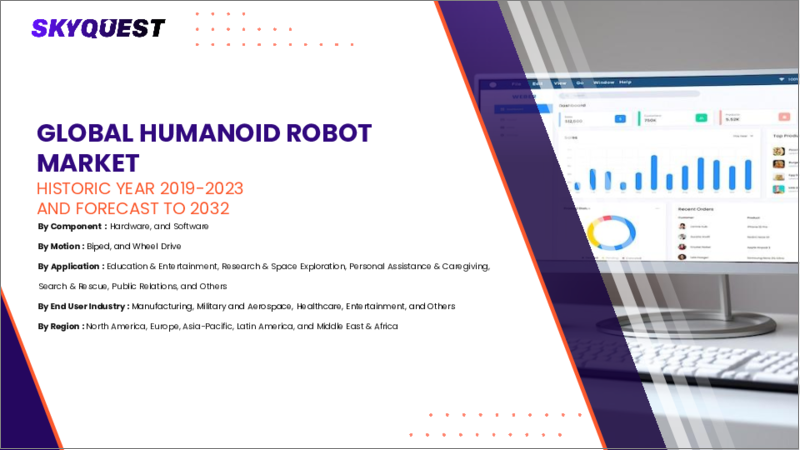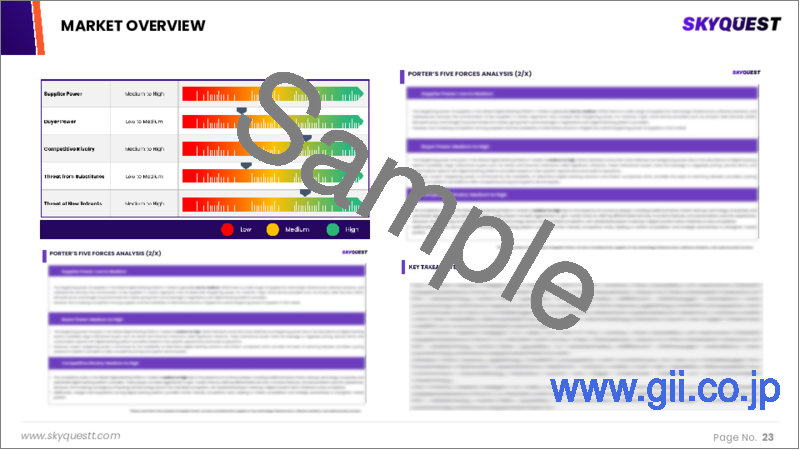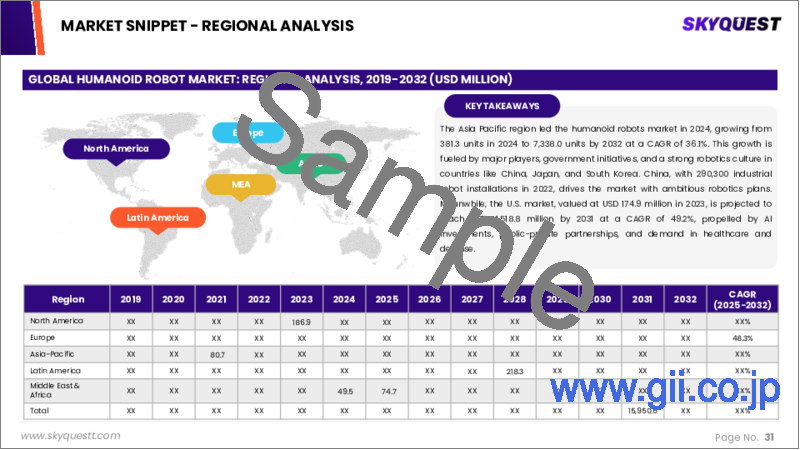|
|
市場調査レポート
商品コード
1701466
ヒューマノイドロボットの市場規模、シェア、成長分析:コンポーネント別、用途別、動作タイプ別、地域別 - 産業予測 2025~2032年Humanoid Robot Market Size, Share, and Growth Analysis, By Component (Hardware, Software), By Application (Personal Assistance & Caregiving, Hospitality), By Motion Type, By Region - Industry Forecast 2025-2032 |
||||||
|
|||||||
| ヒューマノイドロボットの市場規模、シェア、成長分析:コンポーネント別、用途別、動作タイプ別、地域別 - 産業予測 2025~2032年 |
|
出版日: 2025年04月01日
発行: SkyQuest
ページ情報: 英文 157 Pages
納期: 3~5営業日
|
全表示
- 概要
- 目次
ヒューマノイドロボット市場規模は2023年に24億3,000万米ドルとなり、2024年の31億3,000万米ドルから2032年には240億4,000万米ドルに成長し、予測期間(2025~2032年)のCAGRは29.0%で成長する見通しです。
ヒューマノイドロボット市場は、テクノロジーの進歩やヘルスケア、製造、エンターテインメント、パーソナル・アシスタンスなどの多様なアプリケーションに後押しされ、大きな変革期を迎えています。人間の行動を再現するように設計されたこれらのロボットは、労働力不足に対処する一方で、業務効率を高め、顧客との対話を改善するために導入が進んでいます。ロボット工学と人工知能の進化により、人型ロボットはより多用途でシームレスに日常生活に溶け込むようになり、市場拡大の原動力となっています。しかし、規制のハードル、倫理的配慮、開発コストの高さなどの課題が、成長を抑制する可能性があります。ヘルスケアにおける患者モニタリングの役割、学校における双方向の教育機能、RaaS(Robotics as a Service)モデルの台頭といった要因は、人間の労働者との協働を促進し、資金調達、政策、官民パートナーシップを通じてさらなる革新への道を開く、主要な促進要因となっています。
目次
イントロダクション
- 調査の目的
- 調査範囲
- 定義
調査手法
- 情報調達
- 二次と一次データの方法
- 市場規模予測
- 市場の前提条件と制限
エグゼクティブサマリー
- 世界市場の見通し
- 供給と需要の動向分析
- セグメント別機会分析
市場力学と見通し
- 市場概要
- 市場規模
- 市場力学
- 促進要因と機会
- 抑制要因と課題
- ポーターの分析
主な市場の考察
- 重要成功要因
- 競合の程度
- 主な投資機会
- 市場エコシステム
- 市場の魅力指数(2024年)
- PESTEL分析
- マクロ経済指標
- バリューチェーン分析
- 価格分析
- ケーススタディ
- 技術の進歩
- 規制情勢
ヒューマノイドロボット市場規模:コンポーネント別
- 市場概要
- ハードウェア
- センサー
- アクチュエータ
- 電源
- 制御システム
- その他
- ソフトウェア
- サービス
ヒューマノイドロボット市場規模:用途別
- 市場概要
- パーソナルアシスタンスと介護
- ホスピタリティ
- 捜索救助
- 教育とエンターテイメント
- 調査と宇宙探査
- 監視とセキュリティ
ヒューマノイドロボット市場規模:動作タイプ別
- 市場概要
- 二足歩行
- 車輪駆動
ヒューマノイドロボット市場規模
- 北米
- 米国
- カナダ
- 欧州
- ドイツ
- スペイン
- フランス
- 英国
- イタリア
- その他欧州地域
- アジア太平洋地域
- 中国
- インド
- 日本
- 韓国
- その他アジア太平洋地域
- ラテンアメリカ
- ブラジル
- その他ラテンアメリカ地域
- 中東・アフリカ
- GCC諸国
- 南アフリカ
- その他中東・アフリカ
競合情報
- 上位5社の比較
- 主要企業の市場ポジショニング(2024年)
- 主な市場企業が採用した戦略
- 最近の市場動向
- 企業の市場シェア分析(2024年)
- 主要企業の企業プロファイル
- 企業の詳細
- 製品ポートフォリオ分析
- 企業のセグメント別シェア分析
- 収益の前年比比較(2022~2024年)
主要企業プロファイル
- SoftBank Robotics(Japan)
- ROBOTIS(South Korea)
- Agility Robotics(USA)
- UBTECH Robotics(China)
- PAL Robotics(Spain)
- Boston Dynamics(USA)
- Hanson Robotics(Hong Kong)
- Kawada Robotics(Japan)
- Toyota Motor Corporation(Japan)
- Honda Motor Co., Ltd.(Japan)
- Samsung Electronics(South Korea)
- FANUC Corporation(Japan)
- KUKA AG(Germany)
- ABB Ltd.(Switzerland)
- Hyundai Robotics(South Korea)
- Engineered Arts(UK)
- Tesla(USA)
- Figure AI(USA)
- Unitree Robotics(China)
- Sanctuary AI(Canada)
結論と提言
Humanoid Robot Market size was valued at USD 2.43 billion in 2023 and is poised to grow from USD 3.13 billion in 2024 to USD 24.04 billion by 2032, growing at a CAGR of 29.0% during the forecast period (2025-2032).
The humanoid robot market is experiencing a significant transformation, spurred by advancements in technology and diverse applications across healthcare, manufacturing, entertainment, and personal assistance. These robots, designed to replicate human behavior, are being increasingly adopted to enhance operational efficiency and improve customer interactions while addressing labor shortages. The evolution of robotics and artificial intelligence is making humanoid robots more versatile and seamlessly integrated into everyday life, which is set to drive market expansion. However, challenges such as regulatory hurdles, ethical considerations, and high development costs may temper growth. Factors such as their role in healthcare for patient monitoring, the interactive educational capabilities in schools, and the rise of the Robotics as a Service (RaaS) model are key enablers, fostering increased collaboration with human workers and paving the way for further innovation through funding, policies, and public-private partnerships.
Top-down and bottom-up approaches were used to estimate and validate the size of the Humanoid Robot market and to estimate the size of various other dependent submarkets. The research methodology used to estimate the market size includes the following details: The key players in the market were identified through secondary research, and their market shares in the respective regions were determined through primary and secondary research. This entire procedure includes the study of the annual and financial reports of the top market players and extensive interviews for key insights from industry leaders such as CEOs, VPs, directors, and marketing executives. All percentage shares split, and breakdowns were determined using secondary sources and verified through Primary sources. All possible parameters that affect the markets covered in this research study have been accounted for, viewed in extensive detail, verified through primary research, and analyzed to get the final quantitative and qualitative data.
Humanoid Robot Market Segments Analysis
Global Humanoid Robot Market is segmented by Component, Application, Motion Type and region. Based on Component, the market is segmented into Hardware, Software and Services. Based on Application, the market is segmented into Personal Assistance & Caregiving, Hospitality, Search and Rescue, Education and Entertainment, Research and Space Exploration and Surveillance and Security. Based on Motion Type, the market is segmented into Biped and Wheel Drive. Based on region, the market is segmented into North America, Europe, Asia Pacific, Latin America and Middle East & Africa.
Driver of the Humanoid Robot Market
The humanoid robot market is significantly driven by their ability to revolutionize high-risk industries by prioritizing worker safety and mitigating accidents, a pressing concern amplified by the International Labour Organization's findings of 2.3 million annual workplace fatalities, including 350,000 from accidents and 2 million due to occupational diseases. Furthermore, over 313 million workers experience serious injuries each year. By utilizing cutting-edge AI and sophisticated sensors, humanoid robots undertake perilous tasks in challenging environments, drastically reducing human exposure to hazards. This not only enhances productivity but also ensures adherence to safety regulations, underscoring the necessity for such advancements in workplace safety.
Restraints in the Humanoid Robot Market
The global humanoid robot market encounters considerable obstacles primarily due to elevated costs. Research and development expenditures can reach millions of dollars each year, reflecting the complex requirements for creating these advanced machines, which involve sophisticated artificial intelligence, machine learning, precision sensors, and diverse technical expertise. Moreover, limited production volumes and niche application markets contribute to escalating prices. The rapid pace of technological advancements poses additional risks of obsolescence, establishing both financial and adoption barriers that hinder progress for businesses and investors in this evolving field. These challenges underscore the market's hesitance in embracing widespread humanoid robotics.
Market Trends of the Humanoid Robot Market
The integration of Artificial Emotional Intelligence (EmoAI) in humanoid robots is rapidly transforming the Global Humanoid Robots Market, marking a significant trend towards emotional adaptability and enhanced human-robot interactions. EmoAI empowers robots to interpret and respond to complex human emotions, paving the way for more intuitive and empathetic robotic companions. Recent advancements, such as Columbia Engineering's Emo robot, which predicts smiles 840 milliseconds in advance, illustrate the remarkable potential of this technology. As demand for emotionally intelligent robots grows across sectors like healthcare, education, and entertainment, the market is expected to expand significantly, driving innovation and investment in humanoid robotics.
Table of Contents
Introduction
- Objectives of the Study
- Scope of the Report
- Definitions
Research Methodology
- Information Procurement
- Secondary & Primary Data Methods
- Market Size Estimation
- Market Assumptions & Limitations
Executive Summary
- Global Market Outlook
- Supply & Demand Trend Analysis
- Segmental Opportunity Analysis
Market Dynamics & Outlook
- Market Overview
- Market Size
- Market Dynamics
- Drivers & Opportunities
- Restraints & Challenges
- Porters Analysis
- Competitive rivalry
- Threat of substitute
- Bargaining power of buyers
- Threat of new entrants
- Bargaining power of suppliers
Key Market Insights
- Key Success Factors
- Degree of Competition
- Top Investment Pockets
- Market Ecosystem
- Market Attractiveness Index, 2024
- PESTEL Analysis
- Macro-Economic Indicators
- Value Chain Analysis
- Pricing Analysis
- Case Studies
- Technology Advancement
- Regulatory Landscape
Global Humanoid Robot Market Size by Component & CAGR (2025-2032)
- Market Overview
- Hardware
- Sensors
- Actuators
- Power Sources
- Control System
- Others
- Software
- Services
Global Humanoid Robot Market Size by Application & CAGR (2025-2032)
- Market Overview
- Personal Assistance & Caregiving
- Hospitality
- Search and Rescue
- Education and Entertainment
- Research and Space Exploration
- Surveillance and Security
Global Humanoid Robot Market Size by Motion Type & CAGR (2025-2032)
- Market Overview
- Biped
- Wheel Drive
Global Humanoid Robot Market Size & CAGR (2025-2032)
- North America (Component, Application, Motion Type)
- US
- Canada
- Europe (Component, Application, Motion Type)
- Germany
- Spain
- France
- UK
- Italy
- Rest of Europe
- Asia Pacific (Component, Application, Motion Type)
- China
- India
- Japan
- South Korea
- Rest of Asia-Pacific
- Latin America (Component, Application, Motion Type)
- Brazil
- Rest of Latin America
- Middle East & Africa (Component, Application, Motion Type)
- GCC Countries
- South Africa
- Rest of Middle East & Africa
Competitive Intelligence
- Top 5 Player Comparison
- Market Positioning of Key Players, 2024
- Strategies Adopted by Key Market Players
- Recent Developments in the Market
- Company Market Share Analysis, 2024
- Company Profiles of All Key Players
- Company Details
- Product Portfolio Analysis
- Company's Segmental Share Analysis
- Revenue Y-O-Y Comparison (2022-2024)
Key Company Profiles
- SoftBank Robotics (Japan)
- Company Overview
- Business Segment Overview
- Financial Updates
- Key Developments
- ROBOTIS (South Korea)
- Company Overview
- Business Segment Overview
- Financial Updates
- Key Developments
- Agility Robotics (USA)
- Company Overview
- Business Segment Overview
- Financial Updates
- Key Developments
- UBTECH Robotics (China)
- Company Overview
- Business Segment Overview
- Financial Updates
- Key Developments
- PAL Robotics (Spain)
- Company Overview
- Business Segment Overview
- Financial Updates
- Key Developments
- Boston Dynamics (USA)
- Company Overview
- Business Segment Overview
- Financial Updates
- Key Developments
- Hanson Robotics (Hong Kong)
- Company Overview
- Business Segment Overview
- Financial Updates
- Key Developments
- Kawada Robotics (Japan)
- Company Overview
- Business Segment Overview
- Financial Updates
- Key Developments
- Toyota Motor Corporation (Japan)
- Company Overview
- Business Segment Overview
- Financial Updates
- Key Developments
- Honda Motor Co., Ltd. (Japan)
- Company Overview
- Business Segment Overview
- Financial Updates
- Key Developments
- Samsung Electronics (South Korea)
- Company Overview
- Business Segment Overview
- Financial Updates
- Key Developments
- FANUC Corporation (Japan)
- Company Overview
- Business Segment Overview
- Financial Updates
- Key Developments
- KUKA AG (Germany)
- Company Overview
- Business Segment Overview
- Financial Updates
- Key Developments
- ABB Ltd. (Switzerland)
- Company Overview
- Business Segment Overview
- Financial Updates
- Key Developments
- Hyundai Robotics (South Korea)
- Company Overview
- Business Segment Overview
- Financial Updates
- Key Developments
- Engineered Arts (UK)
- Company Overview
- Business Segment Overview
- Financial Updates
- Key Developments
- Tesla (USA)
- Company Overview
- Business Segment Overview
- Financial Updates
- Key Developments
- Figure AI (USA)
- Company Overview
- Business Segment Overview
- Financial Updates
- Key Developments
- Unitree Robotics (China)
- Company Overview
- Business Segment Overview
- Financial Updates
- Key Developments
- Sanctuary AI (Canada)
- Company Overview
- Business Segment Overview
- Financial Updates
- Key Developments





